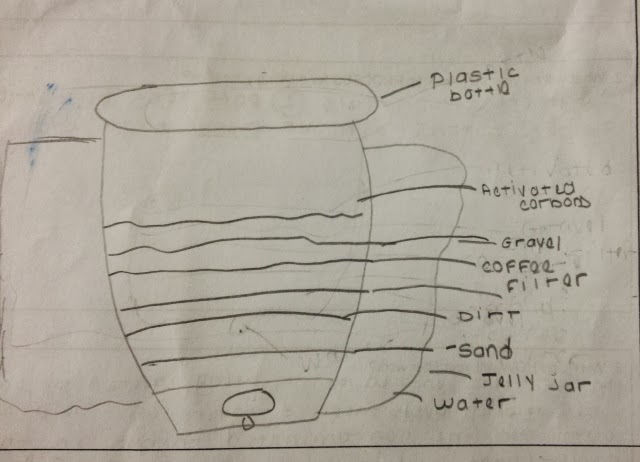The purpose of this action project was to build our own water filter. I had to filter non-potable water into drinkable water. Thanks to this unit I learned how to purify water and find it's pH. I have had many challenges when it came to building the filter but it was all rewarding at the end. Not only do I now know the difference between many waters but I now know what kind of water is safe to drink.
 |
| Photograph RD, Water Filter Graph. 2013 |
The picture above represents my understanding of how a water filter looks and how it works. First to start off I had to gather some materials. Luckily most of the resources I used were natural, so it was very easy having access to them.The highest I payed was $2.10. I needed one Jelly Jar, a pop bottle, sand, gravel, soil and coffee filters. Building this filter, I had to organize and follow each step carefully. The steps that I took to build this was to first of course gather everything I had. The second step I took was to carefully poke holes on the cap on my pop bottle in order for the water to get through. I then put 2 coffee filters in the pop bottle, after that I started filling up the bottle with sand, dirt and gravel.
 |
| Photograph RD. Water Filter. 2013 |
My filter worked by it being layered with all my materials. I used the coffee filters so it can drain out all the contaminated particles in the water. My water filter worked because all my sources were natural. Each source has its own job to do in the cleaning process of this water. This filter is similar to groundwater because it filters the water will all natural materials. I chose this design of a filter because it looked like it would be the simplest and most productive way to filter the water.
Before filtering the river and pond water I tested the pH by putting it on Litmus paper. It had a pH of 4, which is acidic. After filtering the water the pH came out to be 7.2, which is somewhat basic but still drinkable. I calculated the pH’s differences which was 2.8(7.2-4). I know that the equation for pH is -log[H+]. If I convert to a power form and plug in the pH I will get 106^2.8 (631). This would mean that my water was 631 times more basic before filtering. That simply means that the number of hydroxyl ions was increased. Based on my observations and calculations I expect the water to taste fresh and clean.
 |
| Photograph RD Water Filter. 2013 |
Citation
- "Practical Primitive". practicalprimitive.com. Starnater, Eddie. Martin, Julie.LLC. 2012. Web. 28 September 2013.
No comments:
Post a Comment